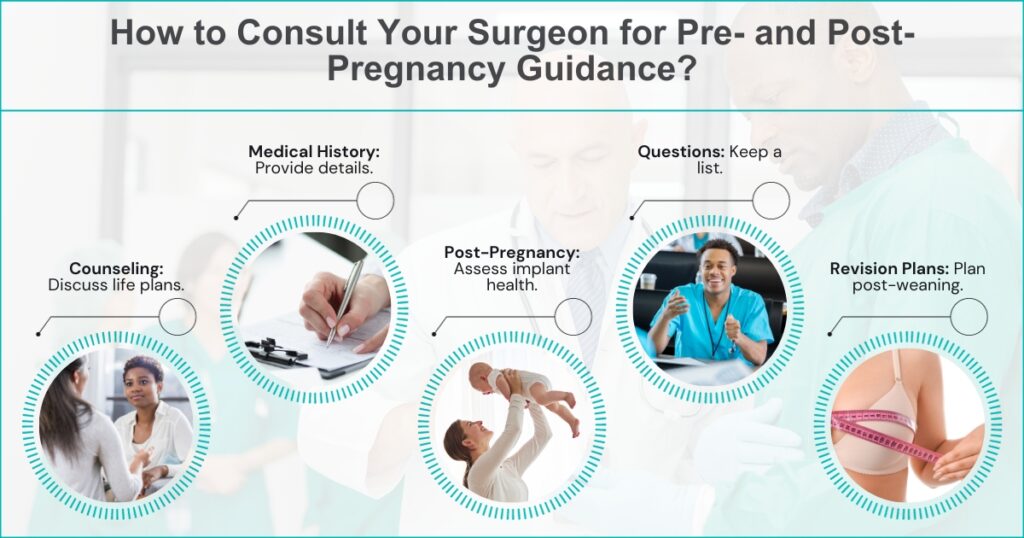A popular cosmetic procedure, breast augmentation, interplays with pregnancy’s transformation in many ways. Women who undergo breast augmentation after pregnancy must be aware of the possible consequences of future pregnancies if they wish to proceed. Each intersection is highlighted in this guide to highlight what every potential patient needs to know.
Understanding Breast Augmentation: The Basics
Breast augmentation is a surgical procedure involving implants or fat transfer to increase breast size. Beyond aesthetics, the procedure can be vital for breast reconstruction post-mastectomy or to balance asymmetrical breasts. Various implant options exist, including silicone, saline, and structured implants.
| Factor | Description | Considerations |
| Types of Implants | Silicone, saline, and structured implants are available. | Discuss with the surgeon. |
| Surgical Techniques | Submuscular, sub-glandular, or dual plane. | Depends on body type and goals. |
| Duration and Recovery | Surgery takes 1-2 hours; recovery varies. | Plan for time off work. |
| Risk Factors | Infection, scarring, capsular contracture. | Discuss with the surgeon. |
| Cost | Typically ranges between AED 18,000 to AED 37,000. | Location and surgeon affect cost. |
| Consultation | An initial appointment to discuss goals and options. | Essential for personalized planning. |
Timing Matters: Best Periods for Breast Augmentation And Pregnancy

Timing your breast augmentation surgery can be crucial if you plan to become pregnant. Opting for the procedure well before you intend to conceive may provide ample recovery time. Additionally, this timeline may minimise potential issues during pregnancy.
| Factor | Description | Consideration |
| Age | Younger or older | May impact timing of augmentation |
| Recovery Time | Approx. 6 weeks | Plan around your pregnancy timeline |
| Conception Plans | Immediate or later | Discuss with surgeon and obstetrician |
| Post-Op Issues | Complications | Timing allows for resolution |
| Future Surgeries | Possible | Consider the need for future revisions |
| Health Check-ups | Necessary | Before planning surgery and pregnancy |
How Pregnancy Affects Breasts: Natural Changes
Pregnancy triggers a series of hormonal changes that significantly impact breast tissue. Breasts often become larger and more sensitive, with the areolas darkening as well. Veins may become more visible due to increased blood flow.
Book A Consultation With Dr Tarek Bayazid
Installment Plan Available
| Factor | Description | Consideration |
| Size Change | Likely | Temporary or possibly permanent |
| Sensitivity | Increased | Due to hormonal changes |
| Skin Changes | Stretch marks, pigmentation | Varies among individuals |
| Vein Visibility | Increased | Due to higher blood volume |
| Hormones | Prolactin, Estrogen | Core regulators of breast changes |
| Postpartum | Size, shape change | May not return to pre-pregnancy form |
Impacts of Breast Augmentation on Pregnancy
Breast augmentation generally does not interfere with a woman’s ability to conceive or carry a pregnancy. However, implants may pose challenges for mammogram screenings and may be sensitive during pregnancy. Silicone implants have a slightly increased risk of complications, according to some research.
Breastfeeding After Breast Augmentation: What You Should Know
Breastfeeding post-augmentation is generally feasible, although some challenges may arise. Implant placement and incision type can impact milk supply and duct functionality. Consult with both a lactation consultant and your surgeon for personalised guidance.
| Factor | Description | Consideration |
| Implant Placement | Submuscular, Subglandular | May affect breastfeeding potential |
| Incision Type | Periareolar, Inframammary | May affect milk ducts |
| Milk Supply | Possible reduction | Varies from woman to woman |
| Consultation | Lactation consultant | For personalized guidance |
| Nipple Sensitivity | May be affected | Could impact breastfeeding |
| Surgical Records | Keep them | For healthcare providers to assess |
Potential for Sagging and Stretch Marks Post-Pregnancy
The natural changes that breasts undergo during pregnancy can exacerbate sagging and stretch marks, even with implants. Hormonal shifts and weight fluctuations contribute to these changes. Breast augmentation does not provide immunity against these natural processes.
Implant Maintenance and Lifespan: Post-Pregnancy Considerations
Breast implants are not lifetime devices; they may require replacement or revision. Pregnancy and breastfeeding can accelerate wear and tear on implants. Periodic monitoring is essential for long-term implant health.
Physical and Emotional Aspects: Body Image During and After Pregnancy
Having breast augmentation and being pregnant can affect body image in a complex manner and you should know everything about what to expect after your breast augmentation surgery. While implants may provide an enhanced silhouette, pregnancy’s physical changes are inevitable. Emotional well-being is equally important in navigating these transformations.
Consulting Your Surgeon: Pre- and Post-Pregnancy

Open and transparent communication with your surgeon is pivotal both before and after pregnancy. Surgeons can provide critical advice on timing, implant types, and potential future revisions. Regular follow-up appointments post-pregnancy are advisable. A 300cc breast size boost means making your breasts bigger by adding 300cc of volume which is like adding a cup size or more
Visible implant edges can be seen when dental implants show through the gums This may happen if the implant is not placed deep enough or if gum tissue is thin
Cost Considerations: Breast Augmentation and Potential Future Procedures
Navigating the financial intricacies of breast augmentation becomes especially pertinent when considering potential future pregnancies. Costs encompass the initial procedure and can extend to potential revisions or complications. Understanding these costs, particularly is vital for comprehensive planning.
| Factor | Description | Consideration |
| Initial Costs | AED 18,000 to AED 37,000 | Based on surgeon and location |
| Financing Options | Available | Check interest rates |
| Insurance Coverage | Generally not covered | May cover complications |
| Future Revision Costs | Similar to initial costs | Plan accordingly |
| Consultation Fees | Varies | Some surgeons charge |
| Hidden Expenses | Lab fees, anaesthesia, etc. | Could add to overall cost |
In the realm of aesthetic medicine, breast augmentation stands prominent. Yet, its intertwining with pregnancy demands informed decision-making. Women are encouraged to familiarise themselves with these considerations, ensuring both the longevity of their implants and the well-being of their maternal experiences.
Whether you’re interested in non-surgical enhancement or a full spectrum of surgical procedures, Dr Tarek Bayazid is a name you can trust. With an MD from Belgrade University and a plastic surgery residency completed at the Clinical Center of Serbia, Dr Tarek is one of Dubai’s premier plastic surgeons.When considering breast implants, it’s crucial to explore various factors that may influence Cost of breast enlargement, ensuring that you make an informed decision about the cost and associated benefits.
His unique and advanced approach, notably in facial rejuvenation and body contouring, has earned him memberships in prestigious international associations like ISAPS and the Serbian Medical Chamber. Patients from around the globe appreciate his commitment to natural results, patient safety, and innovative techniques, such as the composite deep plane facelift. Elevate the quality of your life with unparalleled aesthetic solutions by Dr. Tarek Bayazid.
Don’t let your questions and aesthetic goals go unanswered. Book a consultation with Dr Tarek Bayazid today and step into a new chapter of health and beauty tailored just for you.


